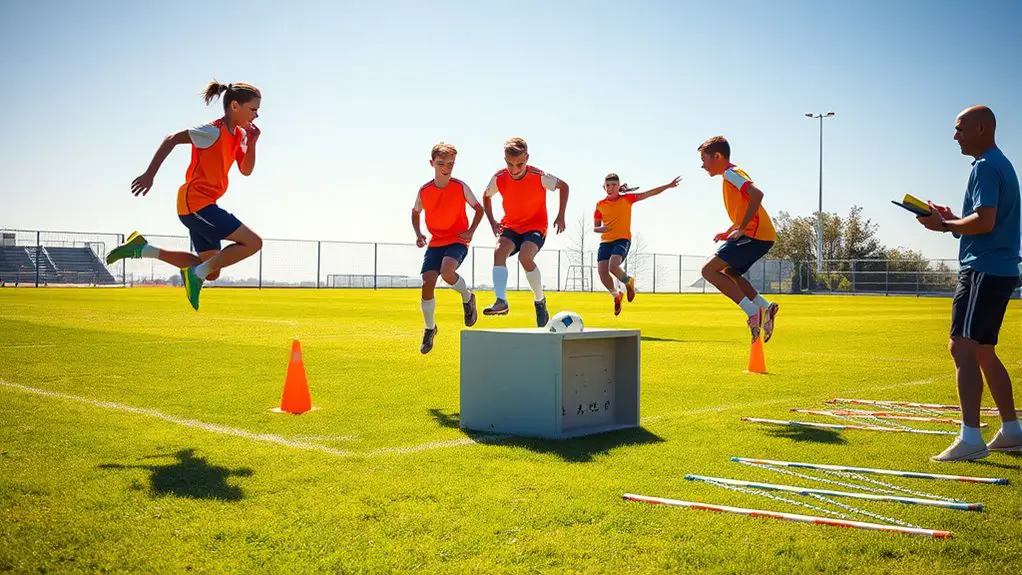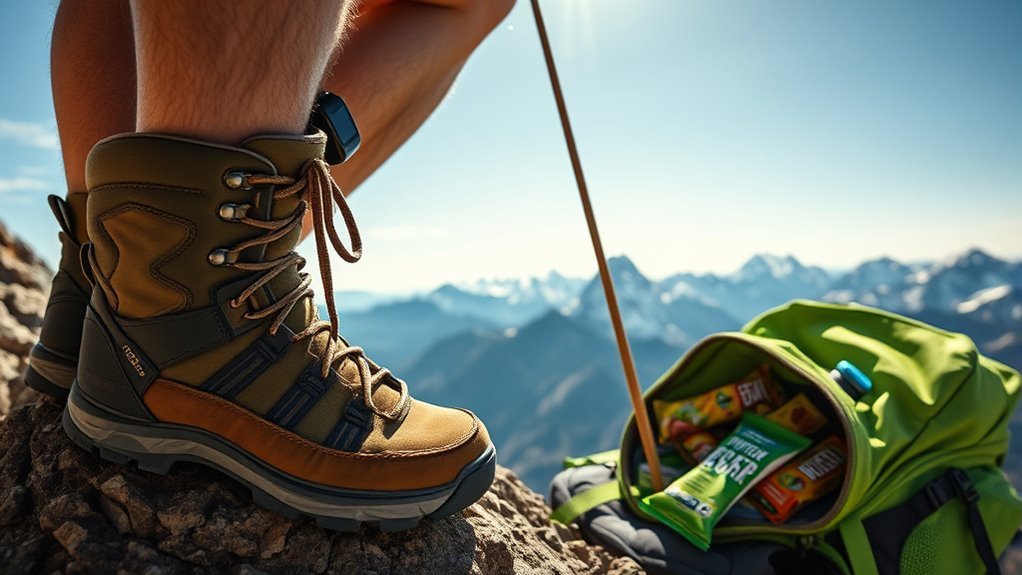Glute activation's essential for sprinters because strong glutes drive your legs forward, enhancing speed and power. Weak glutes limit your explosive force and can lead to injury due to compensatory muscle use. Engaging your glutes improves stability, balance, and overall efficiency in sprinting. Plus, with proper glute activation, you can achieve better recovery times and reduce injury risks. Discover how to effectively incorporate glute activation into your training for maximum performance.
Understanding the Role of Glutes in Sprinting
The glutes play an essential role in sprinting, acting as powerful engines that drive your legs forward. When you sprint, these muscles generate the force needed for explosive starts and quick acceleration. Engaging your glutes helps you maintain balance and stability, allowing you to reach your top speed while keeping your form intact.
When your glutes are firing effectively, you'll notice an increase in your stride length and frequency, giving you that edge you crave on the track. This powerful muscle group not only propels you but also supports your core, contributing to overall agility and coordination. Proper glute activation exercises are crucial for maximizing your sprinting performance and minimizing the risk of injury.
The Impact of Weak Glutes on Performance
Weak glutes can considerably hinder your sprinting performance. When your glutes aren't firing properly, you might find yourself struggling to achieve your full potential on the track. Here's how weak glutes can impact you:
- Reduced Power: You won't generate the explosive force needed for quick starts or powerful strides.
- Poor Stability: Your core and pelvis may lack the stability required for effective sprinting mechanics, leading to imbalances.
- Increased Risk of Injury: Weak glutes can lead to overcompensation from other muscle groups, raising your injury risk.
- Slower Recovery: Without strong glutes, your recovery time may increase, affecting your training frequency and intensity. A strong core reduces injury risk by supporting the spine during exertion, which is essential for sprinters.
Benefits of Glute Activation for Sprinters
When you prioritize glute activation in your training regimen, you'll notice a significant boost in your sprinting performance. Engaging your glutes helps propel you forward, allowing for greater power and speed. You'll find that your stride length increases, giving you that extra edge over competitors.
With activated glutes, you'll also experience improved stability and balance, reducing the risk of injury. This stability lets you push your limits without the fear of setbacks. Plus, strong glutes can enhance your overall body mechanics, ensuring that your energy is efficiently transferred during each sprint. Incorporating squats and deadlifts into your routine can further strengthen your glutes.
You'll feel more in control, allowing you the freedom to focus on achieving your personal best. Embracing glute activation means embracing a more dynamic, powerful sprinting style that can open doors to new possibilities. So, invest in your glutes and watch your performance soar!
Identifying Glute Activation Exercises
To effectively enhance your sprinting performance, incorporating specific glute activation exercises into your routine is essential. These exercises help you wake up those powerful muscles, giving you the strength and stability you need while sprinting. Here are some effective glute activation exercises to evaluate:
- Glute Bridges: Lay on your back, knees bent, and lift your hips towards the ceiling, squeezing your glutes at the top.
- Clamshells: Lie on your side with knees bent, and lift the top knee while keeping your feet together to activate the gluteus medius.
- Single-Leg Deadlifts: Balance on one leg, hinge at the hip, and lower your torso while extending the other leg behind you.
- Donkey Kicks: On all fours, lift one leg, keeping the knee bent, and squeeze your glutes as you lift.
Incorporating these exercises into your training will help you feel more powerful and explosive on the track. Additionally, understanding mobility training can enhance your overall performance by improving movement efficiency and reducing injury risk.
Pre-Sprint Warm-Up Techniques for Glute Activation
Before hitting the track, it's vital to engage in a proper warm-up that activates your glutes and prepares your body for sprinting. Start with dynamic stretches like leg swings and walking lunges to get your blood flowing. Add glute bridges to fire up those muscles; simply lie on your back with your knees bent, lift your hips, and squeeze your glutes at the top. You can also try monster walks using a resistance band around your thighs—this will engage your glutes while you move sideways. Incorporate high knees and butt kicks into your routine for a fun way to enhance hip flexor mobility and activate your glutes further. Remember, the goal is to feel your glutes working before you sprint. When your glutes are ready, you'll experience more power, speed, and efficiency on the track. Dynamic stretching is essential for preparing your muscles for optimal performance. So, let's get those muscles activated and release your potential!
Incorporating Glute Activation Into Sprint Training
With your glutes activated from your warm-up, it's time to integrate that engagement into your sprint training. This connection is essential for powering your strides and enhancing your speed. Here are some effective ways to incorporate glute activation during your sprints:
- Focus on your form: Keep your hips forward and lower back straight to guarantee your glutes are engaged throughout your sprint.
- Utilize sprint drills: Incorporate high-knees and butt kicks to reinforce glute activation while improving your running mechanics.
- Add resistance: Use resistance bands around your thighs during sprints to increase glute engagement and build strength.
- Practice explosive starts: Work on your acceleration out of the blocks, guaranteeing your glutes drive your legs forward for maximum power. Additionally, remember that proper sprinting technique ensures optimal performance and reduces the risk of injury.
Common Mistakes in Glute Activation
When it comes to glute activation, there are a few common mistakes that can hold you back. Skipping a proper warm-up, using poor exercise techniques, and neglecting your core can all hinder your efforts. Additionally, failing to prioritize core stability can significantly impact your glute activation and overall performance. Let's take a closer look at these pitfalls and how to avoid them.
Inadequate Warm-Up Routine
Although many sprinters understand the importance of glute activation, they often overlook the critical warm-up routine that sets the stage for peak performance. An inadequate warm-up can hinder your ability to engage those powerful glutes, leading to subpar sprinting. Avoid these common pitfalls:
- Skipping dynamic stretches that target hip mobility
- Rushing through warm-ups without sufficient time for activation
- Neglecting specific glute-focused exercises like bridges or clamshells
- Failing to include sport-specific movements that mimic sprinting
Improper Exercise Technique
Many sprinters underestimate the impact of improper exercise technique on glute activation, which can greatly affect their performance. When you don't focus on your form, you risk using other muscles instead of engaging your glutes. For example, during squats or lunges, if your knees cave in or your back rounds, you're not just compromising your safety; you're also limiting your glute activation. It's vital to guarantee your hips are aligned, and you're driving through your heels. Often, you might rush through exercises, sacrificing quality for quantity. Slow down, pay attention to your movements, and really feel those glutes working. By correcting these mistakes, you're not just optimizing your training; you're embracing the freedom to perform at your best.
Neglecting Core Engagement
Improper exercise technique isn't the only pitfall that can hinder glute activation; neglecting core engagement is another common mistake. When you ignore your core, you're missing an essential part of the kinetic chain needed for powerful sprinting. A strong core stabilizes your pelvis and enhances glute effectiveness.
Here are some signs you might be neglecting core engagement:
- You're arching your back during exercises.
- Your hips feel unstable or wobbly.
- You struggle to maintain a straight posture while sprinting.
- You find it hard to activate your glutes even during targeted exercises.
The Connection Between Glute Activation and Injury Prevention
How can enhancing glute activation play a significant role in preventing injuries for sprinters? When your glutes are firing properly, they help stabilize your pelvis and hips, reducing strain on your lower back and knees. This stability is essential for maintaining proper form during high-intensity sprints. Without strong glute activation, you might rely more on your hamstrings and quads, leading to imbalances and overuse injuries.
Moreover, strong glutes aid in generating explosive power, allowing for smoother acceleration and deceleration. This not only optimizes your performance but also minimizes the risk of pulls and sprains. By focusing on glute activation, you're not just building strength; you're creating a protective barrier against common sprinting injuries. Incorporating strengthening exercises into your routine can further enhance glute activation and resilience. So, embrace the freedom that comes with well-activated glutes, and enjoy the confidence of sprinting without the constant worry of injury. Your body will thank you for it!
Tracking Progress and Results From Glute Activation
Tracking your progress in glute activation is vital for seeing real improvements. You can measure strength gains through specific exercises and assess how these changes impact your sprint performance. This way, you'll have concrete data to guide your training and help you reach your sprinting goals.
Measuring Strength Improvements
As you incorporate glute activation exercises into your training regimen, it's essential to measure your strength improvements to understand their impact on your performance. Tracking your progress not only keeps you motivated but also helps you identify what's working. Here are some effective ways to measure your strength gains:
- Regular Assessments: Schedule strength tests every few weeks to see how your glute strength is improving.
- Reps and Sets: Track the number of repetitions and sets you can perform over time.
- Resistance Levels: Gradually increase weights or resistance in your exercises to gauge strength growth.
- Mobility Tests: Monitor your range of motion and overall movement efficiency to see if glute activation is enhancing your sprinting mechanics.
Keep pushing, and you'll see those gains!
Assessing Sprint Performance
Wondering how glute activation exercises impact your sprinting performance? You can assess your progress by tracking your sprint times and overall speed. Start by timing yourself over a set distance, like 40 meters, before and after incorporating glute activation into your routine. Notice any improvements in your acceleration and top speed. Additionally, pay attention to your form; strong glutes help maintain proper posture, reducing energy wastage. You might also want to monitor your fatigue levels during workouts. If you're feeling less drained, that's a good sign your glutes are firing properly. Finally, consider using video analysis to observe changes in your running mechanics. These insights will help you embrace the freedom to sprint faster and more efficiently.
Frequently Asked Questions
How Long Does It Take to See Results From Glute Activation?
Ever wondered how quickly your efforts can pay off? Generally, you'll start noticing changes in about 4 to 6 weeks with consistent glute activation. Stick with it, and you'll feel stronger and more liberated in movement.
Can Glute Activation Help With Other Sports Besides Sprinting?
Glute activation can enhance performance in various sports, improving stability, power, and agility. Whether you're into cycling, soccer, or weightlifting, strong, engaged glutes can boost your overall athletic ability and prevent injuries.
What Are the Signs of Proper Glute Activation?
You'll know your glutes are activated when you feel a strong connection during movement. If you notice stability, power, and less lower back strain, those signs mean you're releasing your body's true potential and freedom.
Are There Any Age Restrictions for Glute Activation Exercises?
There aren't any strict age restrictions for glute activation exercises. You can start at any age, but it's best to listen to your body and consult a professional if you're unsure about your capabilities.
How Often Should I Perform Glute Activation Workouts?
You should aim to perform glute activation workouts at least three times a week. Notably, studies show that just 10 minutes of focused activation can enhance performance dramatically, giving you more freedom in your movements.




